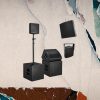
Review: Universal Audio SD-1
Has the SM7B finally met its match?
One glance at the Universal Audio SD-1 and you know its design inspiration comes from a certain blacked-out counterpart. And, even though at this point of me writing this review I haven’t actually heard how the mic sounds, I dare say the SD-1 attempts to mimic more than merely the aesthetic of the esteemed Shure SM7B. Considered the gold standard microphone for speech-related applications, the SM7B nails that delightful sweet spot of producing a natural and un-hyped vocal tone: the tight cardioid pickup pattern yields a focused sound that ignores spill and reflections; the dynamic capsule beautifully tames harsh sibilance; and its long grille catches and eradicates pesky plosives. Add to that, the SM7B features switches on the rear for making useful tonal tweaks, a right-angle cable connection which pairs neatly with broadcast boom arms, and a slick aesthetic loved by YouTubers.
But there’s a couple of downsides. Firstly, the SM7B needs a lot of gain. Secondly, at around AU$700, it isn’t exactly a steal.
LOOK & FEEL
Meet the Universal Audio SD-1 dynamic microphone. For starters, let’s acknowledge the fact that UA is now making mics – it has been for a few years now. With other similar companies, that might be reason to raise an eyebrow. But with Universal Audio’s proven pedigree and proficiency in both audio hardware and software design, I’m actually rather excited by the prospect of a no-frills workhorse dynamic mic coming from UA’s direction.
The SD-1’s form factor gives the immediate impression of a broadcast microphone but Universal Audio assures us it’ll sit comfortably in a recording studio in front of sung vocals and instruments too. Technical details on the UA site are sparse: the SD-1 has a stated frequency response of 50Hz–16kHz (-3dB?), a cardioid polar pattern, internal shockmounting, and a couple of tonal adjustment switches. Physically, it’s a bold yet sleek design with no sign of manufacturing corners cut. Everything from the yokemount knobs to the XLR connector feels rugged and ready for action. The beige paint job will match any environment.
SOUND
The big question: how does it sound? In short, and as expected; it sounds excellent.
‘Tight’ and ‘clean’ are the words that come to mind. This isn’t a bottom-heavy mic with blossoming low end. Rather its frequency response gently draws attention to the upper mids of a voice where prime intelligibility lives. There’s a definite high fidelity characteristic to the SD-1. Trebles are more present than I expected but not in a way that makes it a ‘bright’ sound. There’s simply lots of detail; be it in a quietly spoken word or phrase or extended high end response on a musical instrument – sources never present as muffled or muted. I couldn’t detect nasal or muddy low mids dirtying things up like so many other dynamic mics tend to do. A further high/mid boost can be engaged with a dip switch on the back of the mic which creates a noticeable push forward in the forthrightness of a sound. I’d see myself using this only when a soft and placid source calls for it.
Because the SD-1 isn’t inherently boomy, proximity can be utilised to great effect. You’ll also get the best signal to noise ratio with the mic close to the presenter’s mouth.
NEED TO KNOW
Universal Audio SD-1
Dynamic Microphone


NO FEAR OF REJECTION
Rear rejection is outstanding. There’s no doubt a group of SD-1s will produce clean and tidy recordings on multiple presenters in the same room. What’s more, the off-axis sound, while heavily attenuated, also sounds natural and pure. This instils confidence in a studio context, too – when the mic is pressed up against a guitar amp or inside the bell of a trumpet, rest assured the minimal spill you get from the rest of the band will only aid and not hinder the mix. And the SD-1 does indeed excel beyond speech applications. It suited the earthy tone of my Martin acoustic guitar nicely and lent it a punchy presence. The extended frequency response means you can stick it on rock or hip hop vocals for polished results while keeping that signature dynamic mic grittiness.
But back to a spoken word scenario… After reviewing a multitude of podcast mics I have come to realise that a plosive-destroying grille and windshield is rare. As a result I instinctively slur my ‘puhs’ and ‘buhs’ when speaking into a mic, with the burdensome expectation that the smallest puff of air will overwhelm the capsule. Not so with the SD-1. The long foam windshield (and whatever it is underneath it) does a stellar job stopping plosives in their tracks even when my lips were in very close quarters. Unlike the SM7B, the foam windshield doesn’t appear to be detachable, which is a shame as I’d have loved to see what materials Universal Audio used inside. I imagine the length of the windshield creates a decent distance to the capsule allowing more time and space for plosives to dissipate – a trick the SM7B grille performs commendably. If you’re finding some pops and booms are still worming their way into the mic then flick the high-pass filter switch on the back. UA doesn’t specify the HPF cutoff frequency but it’s high enough to virtually eliminate all rumbly low end.
BIG GAINS
Gaining up the SD-1 for my voice required nearly all of the +60dB my preamp could give it. This is hardly a problem these days given most off-the-shelf interfaces are capable of a bucketload of clean gain, but it’s worth bearing in mind if you plan to use the SD-1 for a particularly quiet source. For example, tracking fingerpicked acoustic guitar will be a challenge without a better-than-average pre.
Using the SD-1 with UAD Apollo interfaces unlocks more from the mic. Custom Channel Strip presets for the SD-1 are available on the Universal Audio website for instant use via your Apollo interface software.
I wouldn’t call the Universal Audio SD-1 an all-rounder. Then again, we wouldn’t give the Shure SM7B that title either. The forwardness of the high mids and the modest output narrows the universality of its use cases. The SD-1 is a mic that shines on spoken word applications and will be a podcaster’s best friend. It’s a mic that holds its own in front of musical instruments especially when you’re chasing good isolation or a more rugged-sounding alternative to a condenser. And it’s a mic that doesn’t need to be coddled – it’s built for a life of serious work.

























RESPONSES